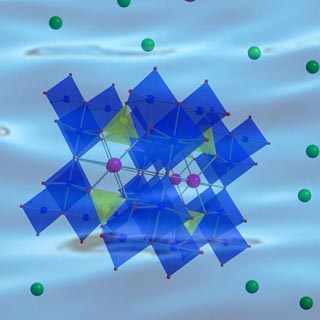
Sandia was honored four times by the Federal Laboratory Consortium (FLC) for its work to develop and commercialize innovative technologies.
The FLC’s Far West/Mid-Continent regional awards recognized Sandia’s technology transfer work with crystalline silico-titanates (CSTs), biomimetic membranes, DAKOTA software, and the i-Gate Innovation Hub.
“It is always gratifying when the Federal Laboratory Consortium shines a light on the amazing work that is taking place at Sandia National Laboratories,” says Jackie Kerby Moore, manager of Technology and Economic Development Dept. 1933 and Sandia’s representative to the FLC. “They recognized the entire spectrum of our work, from technology development to technology transfer, as well as the economic impact that technology transfer creates."
CST ion exchangers
The Excellence in Technology Transfer award went to people involved in development and commercialization of CSTs — business development specialist Bianca Thayer (1931), Geochemistry Dept. 6915 Manager Mark Rigali, and researcher Tina Nenoff (1114).
CSTs are inorganic, molecularly engineered ion exchangers that can remove high-level radioactive contaminants such as cesium from wastewater. UOP, a Honeywell company, licensed the Sandia technology in the mid-1990s and revised the license last year to become the exclusive US manufacturer of CSTs.
CSTs played a role when the Fukushima Daiichi nuclear power plant outside Tokyo was damaged in an earthquake and tsunami on March 11, 2011. Seawater was pumped in to cool the reactors. The water was contaminated with cesium and could not be released back into the ocean.
Tina, who had experience developing and working with CSTs in the 1990s, was called upon to test the material for removal of cesium in seawater. She worked around the clock for 10 days, concluding that CSTs outperformed other materials in removing cesium from seawater.
Honeywell UOP products with CST technology have successfully treated more than 40 million gallons of contaminated water at Fukushima.
Biomimetic membranes
The Notable Technology Development award recognized researcher Susan Rempe (8635) and her team’s work with biomimetic membranes, a revolutionary advance in the field of membrane technology for water filtration.
Nearly half the world’s population has inadequate access to clean, fresh water. Desalination plants pass salt water through membranes that remove salts and create drinkable water. But membrane technology has advanced slowly the past 30 years.
The biomimetic membrane, inspired by how the human body filters water, uses self-assembly and atomic layer deposition. It is designed for water purification using reverse osmosis technology, which removes impurities with applied pressure powered by electrical energy.
The Sandia technology received an R&D 100 Award in 2011. “We made a synthetic membrane that mimics the nanoscale design features of natural water purification channels,” Susan says. “By doing so, our initial membranes achieved a 10-fold improvement in water purification efficiency compared with state-of-the-art RO membranes.”
Biomimetic membranes can increase access to clean water by dramatically reducing energy use and costs.
i-GATE
The Outstanding Partnership Award recognized the i-GATE regional public-private partnership in California designed to support small businesses and maximize the economic potential of green transportation and clean-energy technologies. i-GATE (Innovation for Green Advanced Transportation Excellence) creates a link between national laboratories and entrepreneurs, industry, venture capital, universities, and economic development resources to accelerate the commercialization of energy technologies and grow a cohesive innovation ecosystem.
The i-Gate National Energy Systems Technology (NEST) incubator opened in June 2011 to help small companies work with advanced transportation or renewable energy technologies that can leverage technical assistance from Sandia/California or Lawrence Livermore National Laboratory. The i-GATE NEST has helped create 62 direct and 118 indirect jobs.
The award recognized Bruce Balfour (8539), a Sandia technical business development specialist and i-GATE president; Rob White, city of Livermore Economic Development director and i-GATE CEO; Louis Stewart, deputy director of Innovation and Entrepreneurship, California Governor’s Office of Business and Economic Development; and Buck Koonce, director of Economic Development at Lawrence Livermore National Laboratory.
DAKOTA software
The fourth FLC award was an honorable mention for Notable Technology Development that went to DAKOTA software and the project lead, computer scientist Brian Adams (1441). Engineers often need computational simulations to solve scientific problems.
Sandia’s Design Analysis Kit for Optimization and Terascale Applications (DAKOTA) is an open-source software tool that helps researchers adjust and assess the accuracy of such models.
DAKOTA helps researchers know if their simulations are accurate and how they can be optimized to produce the most realistic, reliable predictions. The software answers such questions as how reliable or variable a system is and what models or parameters best match experimental data.
DAKOTA shortens design cycles and cuts development costs. It is used extensively at national laboratories to solve a wide range of energy and national security-related problems, and to conduct research with academic, government, and industrial partners.
“This year we were honored for our technology transfer successes across the globe as well as closer to home,” Jackie says. “Whether our impact was in Japan or our own Livermore community, our technologies and our people are making a difference.”
The FLC is a nationwide network of more than 300 members that provides the forum to develop strategies and opportunities for linking laboratory mission technologies and expertise with the marketplace.
The FLC Awards Program annually recognizes federal laboratories and their industry partners for outstanding technology transfer efforts. Since its establishment in 1984 the FLC has presented awards to nearly 200 federal laboratories, becoming one of the most prestigious honors in technology transfer.